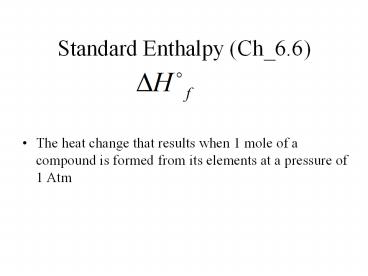Standard%20Enthalpy%20(Ch_6.6) PowerPoint PPT Presentation
Title: Standard%20Enthalpy%20(Ch_6.6)
1
Standard Enthalpy (Ch_6.6)
- The heat change that results when 1 mole of a
compound is formed from its elements at a
pressure of 1 Atm
2
- Energy is the capacity to do work
- Radiant energy comes from the sun and is earths
primary energy source - Thermal energy is the energy associated with the
random motion of atoms and molecules - Chemical energy is the energy stored within the
bonds of chemical substances - Nuclear energy is the energy stored within the
collection of neutrons and protons in the atom - Potential energy is the energy available by
virtue of an objects position
6.1
3
Thermodynamics
State functions are properties that are
determined by the state of the system, regardless
of how that condition was achieved.
energy
, pressure, volume, temperature
DE Efinal - Einitial
Potential energy of hiker 1 and hiker 2 is the
same even though they took different paths.
6.3
4
DEsystem DEsurroundings 0
or
DEsystem -DEsurroundings
Exothermic chemical reaction!
6.3
5
Another form of the first law for DEsystem
DE q w
DE is the change in internal energy of a system
q is the heat exchange between the system and the
surroundings
w is the work done on (or by) the system
w -PDV when a gas expands against a constant
external pressure
6.3
6
A Comparison of DH and DE
DE DH - PDV
At 25 0C, 1 mole H2 24.5 L at 1 atm
PDV 1 atm x 24.5 L 2.5 kJ
DE -367.5 kJ/mol 2.5 kJ/mol -370.0 kJ/mol
6.4
7
Because there is no way to measure the absolute
value of the enthalpy of a substance, must I
measure the enthalpy change for every reaction of
interest?
The standard enthalpy of formation of any element
in its most stable form is zero.
6.6
8
Calculate the standard enthalpy of formation of
CS2 (l) given that
1. Write the enthalpy of formation reaction for
CS2
2. Add the given rxns so that the result is the
desired rxn.
6.6
9
Benzene (C6H6) burns in air to produce carbon
dioxide and liquid water. How much heat is
released per mole of benzene combusted? The
standard enthalpy of formation of benzene is
49.04 kJ/mol.
6.6
10
The enthalpy of solution (DHsoln) is the heat
generated or absorbed when a certain amount of
solute dissolves in a certain amount of solvent.
DHsoln Hsoln - Hcomponents
Which substance(s) could be used for melting ice?
Which substance(s) could be used for a cold pack?
6.7
11
Standard Enthalpy
- The standard enthalpy of formation, of any
element in its most stable form is zero - Therefore C (graphite) is more stable than C
(diamond)
12
Consider the reaction
Where a,b,c and d are the stoichiometric
coefficients, then we can write
13
6.18
14
To use this equation to determine the standard
enthalpy
- We must know the values of the
compounds that take place in the reaction to use
either the direct or indirect methods
15
The Direct Method
- If we can directly synthesize a compound from its
elements, we have a direct measurement of - An example is
16
The Indirect Method
- If we cant directly synthesize the product we
can use Hesss law When reactants are converted
to products, the change in enthalpy is the same
whether the reaction takes place in 1 step or a
series of steps. - is a state function
17
Some Possible Exam Questions
- Define standard enthalpy of formation?
- Equation for the definition of enthalpy is
- Why is it important to indicate physical states
when writing thermochemical equations? - Calculate the ?Hf for the burning of ethanol
given the enthalpies of formation of the
reactants. Remember to balance the equation in
the process

